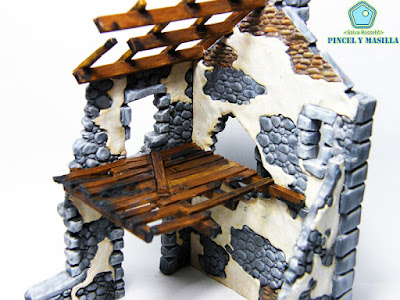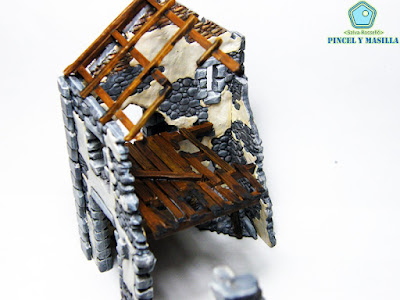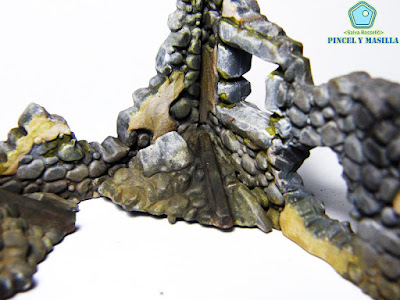[28mm] House in Ruin - Environmental Weathering
En el anterior artículo, terminé de pintar la casa en ruina, a falta del envejecimiento.
In the previous article, I finished painting the house in ruins, in the absence of aging.
Para el envejecimiento he partido del concepto que esta casa fue incendiada en su momento, pero hace ya bastante tiempo de ello.
For aging I have started from the concept that this house was burned down at the time, but it has been a long time ago.
Para poder representar esta condición, he optado por aplicar un envejecimiento inicial de la madera de la 1ª planta y de la estructura del tejado.
Para ello he usado:
- Base Camuflaje Splinter (Panzer Aces 345), mediante un pincel seco intenso para dar un aspecto de madera quemada por el sol, y no por las llamas.
- Gris Plateado (Model Color 883 – 152), a pincel seco, para dar luces sobre el Splnter.
- Lavado Negro (Game Wash 201, aplicado únicamente en las zonas que se han determinado como quemadas.
In order to represent this condition, I have chosen to apply an initial aging of the wood of the 1st floor and of the roof structure.
For this I have used:
- Splinter Camouflage Base (Panzer Aces 345), using an intense dry brush to give a wood look burned by the sun, and not by the flames.
- Silvergrey (Model Color 883 - 152), with a dry brush, to highlight the Splnter.
- Black Shade (Game Wash 201, applied only to areas that have been determined to be burned.
Con estos colores se considera “casi” terminado el tratamiento a las maderas.
With these colors the wood treatment is considered “almost” finished.
Para continuar con un acabado de envejecimiento, aplicaré un par de lavados más, pero esta vez en bajos y recovecos, para dar un efecto de mohosidad, pero sin llegar a la exageración.
Para ello he usado:
- Verde Oscuro (Model Wash 512), para representar el moho entre las juntas de las piedras, de forma aleatoria.
- Verde Oliva (Model Wash 519), para el moho sólo en los bajos del edificio y en zonas de los listones de las maderas.
To continue with an aging finish, I will apply a couple more washes, but this time in low and nooks, to give a musty effect, but without going overboard.
For this I have used:
- Dark Green (Model Wash 512), to represent the mold between the joints of the stones, in a random way.
- Olive Green (Model Wash 519), for mold only on the underside of the building and in areas of the wood slats.
Recordar que para eliminar el exceso y que no se vea el límite del pigmento, se debe humedecer con diluyente un pincel limpio de pintura.
Personalmente utilizo el Diluyente para Aerógrafo (Auxiliar 161), ya que a mí me da mejor resultado que cualquier otro thinner o agua destilada.
Remember that to remove the excess and not see the limit of the pigment, a clean paint brush should be moistened with thinner.
I personally use the Airbrush Thinner (Auxiliary 161), since it gives me better results than any other thinner or distilled water.
A la edificación más pequeña, se le trata de la misma forma.
The smallest building is treated in the same way.
Ya tengo las edificaciones bastante realista, ahora le toca el turno a los pigmentos.
Estos los he usado para dar efecto de polvo a zonas determinadas.
Estos pigmentos han sido:
- Pizarra Oscura (Pigmentos 114), aplicado directamente sobre los escombros, para dar efecto de polvo viejo y para seguir ganando profundidad a estas piezas.
- Pizarra Clara (Pigmentos 113) para dar sensación de polvo en las piezas de escombros.
- Sombra Natural (Pigmentos 109), aplicado en todos los bajos, para dar la sensación de barro ligero pegado a las paredes de los edificios.
- Negro Carbón (Pigmentos 116). Este pigmento se aplica en todas las maderas que se han pintado dando el efecto de quemado, más en las paredes interiores y zonas superiores exteriores de las ventanas, puertas y huecos, ya que se consigue:
a) en las maderas quemadas, da el efecto de carbón.
b) en paredes da el efecto de ahumado.
I already have the buildings quite realistic, now it is the turn of the pigments.
These I have used to give a powder effect to certain areas.
These pigments have been:
- Dark Slate (Pigments 114), applied directly on the rubble, to give the effect of old dust and to continue gaining depth to these pieces.
- Clear Slate (Pigments 113) to give the sensation of dust in the pieces of rubble.
- Natural Shadow (Pigments 109), applied to all the basements, to give the sensation of light mud stuck to the walls of the buildings.
- Carbon Black (Pigments 116). This pigment is applied to all the woods that have been painted giving the effect of burning, more in the interior walls and exterior upper areas of the windows, doors and openings, since it is achieved:
a) In burned woods, it gives the effect of charcoal.
b) on walls gives the effect of smoked.
Con el pigmento negro, no podemos olvidar de ennegrecer la chimenea.
With the black pigment, we cannot forget to blacken the fireplace.
La vista general del edificio de dos plantas terminado es este.
La vista general del edificio de dos plantas terminado es este.
A la edificación de una planta, se trata de la misma forma que lo realizado en el de dos plantas.
The one-story building is treated in the same way as the two-story building.
Espero que os sirva para vuestros trabajos.
I hope it helps you for your work.



























